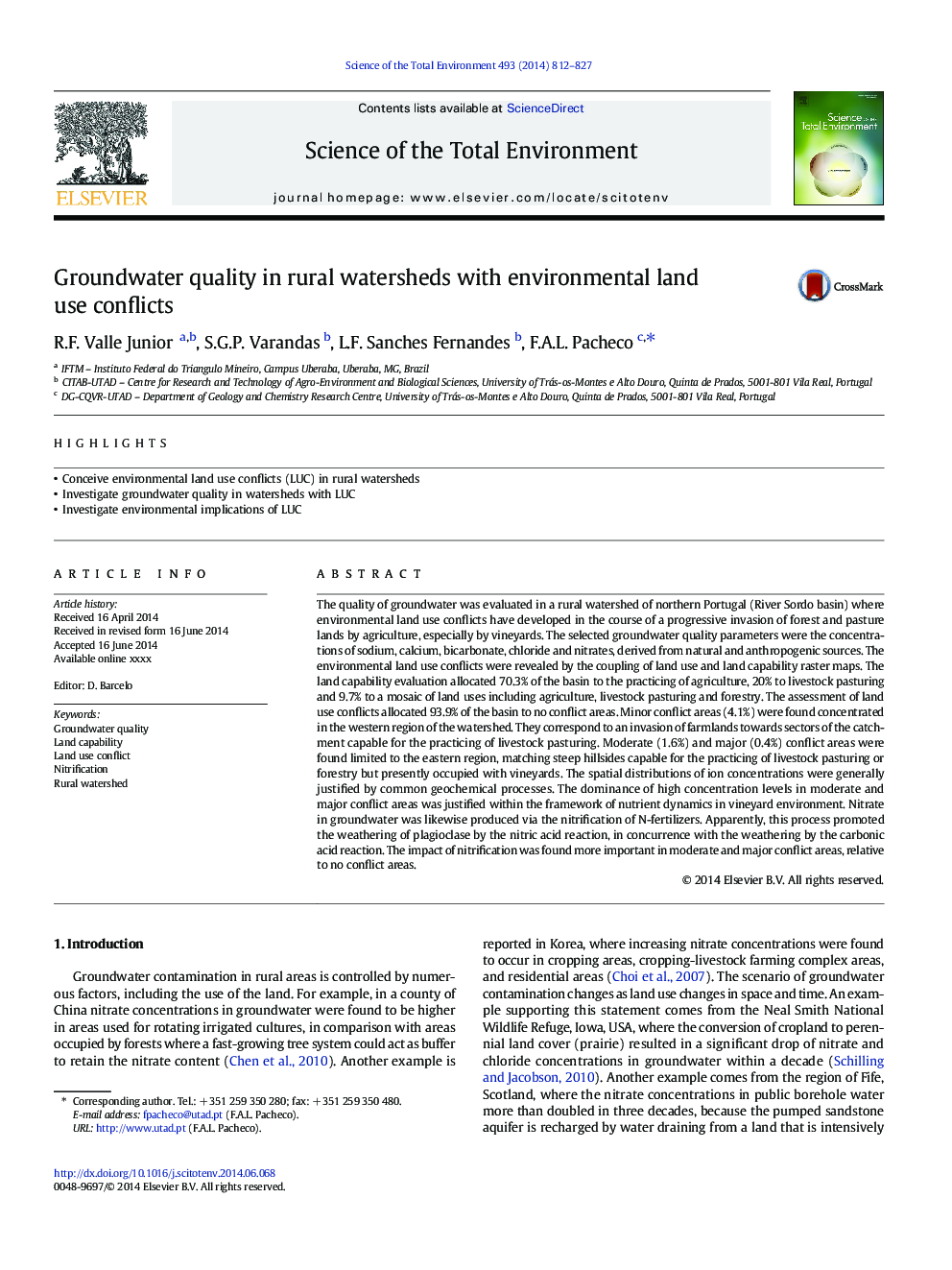| کد مقاله | کد نشریه | سال انتشار | مقاله انگلیسی | نسخه تمام متن |
|---|---|---|---|---|
| 6329851 | 1619778 | 2014 | 16 صفحه PDF | دانلود رایگان |
عنوان انگلیسی مقاله ISI
Groundwater quality in rural watersheds with environmental land use conflicts
ترجمه فارسی عنوان
کیفیت آبهای زیرزمینی در حوزه های آبخیز روستایی با درگیری های استفاده از زمین های زیست محیطی
دانلود مقاله + سفارش ترجمه
دانلود مقاله ISI انگلیسی
رایگان برای ایرانیان
کلمات کلیدی
ترجمه چکیده
کیفیت آبهای زیرزمینی در آبهای روستایی شمال پرتغال (حوضه رودخانه سوردو) مورد ارزیابی قرار گرفت. درنتیجه جنگل های زیست محیطی در طی جنگ متلاشی شده با کشاورزی، به ویژه توسط باغ های انگور توسعه یافتند. پارامترهای کیفیت آبهای زیرزمینی شامل غلظت سدیم، کلسیم، بی کربنات، کلرید و نیترات از منابع طبیعی و انسان شناسی بود. مناقشات استفاده از زمین های زیست محیطی بوسیله ترکیب نقشه های کشوری و نقشه های زمین مورد استفاده قرار گرفت. ارزیابی قابلیت های زمین 3/70 درصد از حوضه را به تمرین کشاورزی، 20 درصد برای پرورش دام و 7/9 درصد برای موزاییک استفاده از زمین، از جمله کشاورزی، پرورش دام و جنگلداری اختصاص داده است. ارزیابی درگیری های استفاده از زمین 93.9٪ از حوضه را به مناطق بدون درگیری اختصاص داده است. مناطق متضاد جزئی (4.1٪) در منطقه غربی حوزه آبریز متمرکز شدند. آنها به تهاجم به زمین های کشاورزی نسبت به بخش های حوضه ای که قادر به تمرین حراست دام می باشند، مطابقت دارد. مناطق متداول (1.6٪) و عمده (0.4٪) مناطق جنگلی محدود به منطقه شرقی بودند که با تپه های تپه ای قابل اجرا برای پرورش گاو و یا جنگلداری، اما در حال حاضر با تاکستان های اشغال شده بودند. توزیع فضایی غلظت یون به طور کلی توسط فرآیندهای ژئوشیمیایی رایج به دست می آید. غلبه بر سطوح بالای غلظت در مناطق متداول و اصلی، در چارچوب دینامیک مواد مغذی در محوطه باغ وحش مورد توافق قرار گرفت. نیترات در آب های زیرزمینی نیز از طریق نیتریفیکاسیون کود نیتروژن تولید می شود. ظاهرا، این فرآیند واکنش پلاژیوکلاز توسط واکنش اسید نیتریک را به همراه واکنش با واکنش اسید کربنیک مطرح کرد. تأثیر نیتریفیکاسیون در مناطق درگیری متوسط و بزرگ، در مقایسه با مناطق متضاد، بیشتر اهمیت دارد.
موضوعات مرتبط
علوم زیستی و بیوفناوری
علوم محیط زیست
شیمی زیست محیطی
چکیده انگلیسی
The quality of groundwater was evaluated in a rural watershed of northern Portugal (River Sordo basin) where environmental land use conflicts have developed in the course of a progressive invasion of forest and pasture lands by agriculture, especially by vineyards. The selected groundwater quality parameters were the concentrations of sodium, calcium, bicarbonate, chloride and nitrates, derived from natural and anthropogenic sources. The environmental land use conflicts were revealed by the coupling of land use and land capability raster maps. The land capability evaluation allocated 70.3% of the basin to the practicing of agriculture, 20% to livestock pasturing and 9.7% to a mosaic of land uses including agriculture, livestock pasturing and forestry. The assessment of land use conflicts allocated 93.9% of the basin to no conflict areas. Minor conflict areas (4.1%) were found concentrated in the western region of the watershed. They correspond to an invasion of farmlands towards sectors of the catchment capable for the practicing of livestock pasturing. Moderate (1.6%) and major (0.4%) conflict areas were found limited to the eastern region, matching steep hillsides capable for the practicing of livestock pasturing or forestry but presently occupied with vineyards. The spatial distributions of ion concentrations were generally justified by common geochemical processes. The dominance of high concentration levels in moderate and major conflict areas was justified within the framework of nutrient dynamics in vineyard environment. Nitrate in groundwater was likewise produced via the nitrification of N-fertilizers. Apparently, this process promoted the weathering of plagioclase by the nitric acid reaction, in concurrence with the weathering by the carbonic acid reaction. The impact of nitrification was found more important in moderate and major conflict areas, relative to no conflict areas.
ناشر
Database: Elsevier - ScienceDirect (ساینس دایرکت)
Journal: Science of The Total Environment - Volume 493, 15 September 2014, Pages 812-827
Journal: Science of The Total Environment - Volume 493, 15 September 2014, Pages 812-827
نویسندگان
R.F. Junior, S.G.P. Varandas, L.F. Sanches Fernandes, F.A.L. Pacheco,
